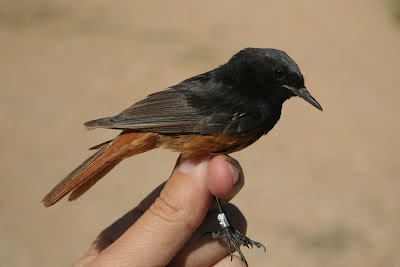Two days ago (05/06) I ringed at JBO, quite a poor
morning. After two nice months of spring migration the silence in area is very
jarring. I caught 15 birds, most were late migrants that probably won't make it
anywhere. Apart from this, there were only few juveniles of breeding population
species. Most migrants were found around our Mulberry Trees, with the last
berries remaining on those trees.
 |
| Eastern Olivaceous Warbler |
After the moody report above, happier news came
from Tzor'a. I ringed on Friday and discovered the fruits of a very successful
breeding season. Eight nets for four hours produced a very busy morning. Most
birds were Reed Warblers and Cetti's Warblers, but also present were other
local species.
Compared to last year in same date and same
nets:
2011: 44 birds, 2012: 84 birds
2011: 13 females with brood patch, 2012:
12 females with brood patch
2011: 7 fledglings, 2012: 27
fledglings
2011: 0.5 fledglings per breeding female, 2012:
2.3 fledglings per breeding female




.JPG)
.JPG)




.JPG)
.JPG)





.JPG)
.JPG)



.JPG)



.JPG)
.JPG)

.JPG)
.JPG)
.JPG)
.JPG)










.jpg)
.jpg)
.jpg)
.jpg)
.jpg)
.jpg)



